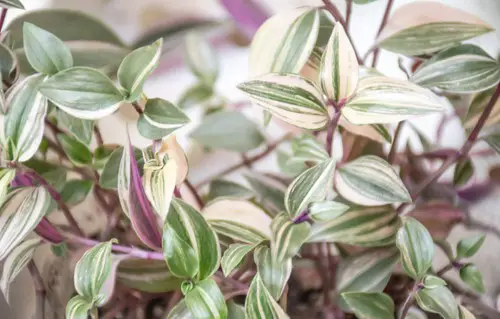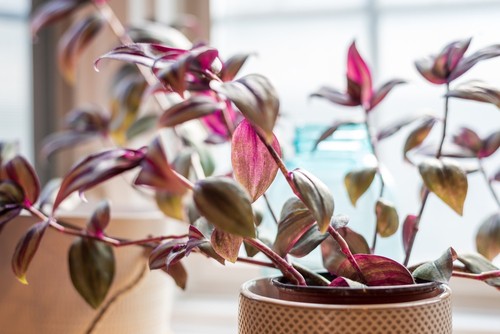Wandering Jew plants are a popular houseplant known for their striking foliage and easy care. However, one common problem that many plant owners face is wandering jew leaves turning yellow. This can be alarming, but it is often a sign of an easily fixable issue.
Understanding Wandering Jew plants is key to identifying the cause of yellowing leaves. Tradescantia zebrina, commonly known as Wandering Jew, is a trailing plant with purple and green leaves.
It prefers bright, indirect light and moist soil. Overwatering or poor drainage can cause root rot, leading to yellowing leaves. Pests such as spider mites and aphids can also cause discoloration.
Ideal growing conditions for Wandering Jew plants include bright, indirect light and well-draining soil. Care and maintenance involve regular watering, but not overwatering, and occasional fertilization.
Propagation methods include stem cuttings and division. By following these guidelines, plant owners can prevent yellowing leaves and keep their Wandering Jew plants healthy and vibrant.
Key Takeaways
- Yellowing leaves on Wandering Jew plants can be a sign of overwatering, poor drainage, or pest infestation.
- Ideal growing conditions for Wandering Jew plants include bright, indirect light and well-draining soil.
- Care and maintenance involve regular watering, occasional fertilization, and propagation through stem cuttings or division.
Also read:
Understanding Wandering Jew Plants

Wandering Jew plants, also known as inch plants or spiderworts, are popular houseplants known for their beautiful, trailing foliage. They are scientifically known as Tradescantia zebrina and are native to Mexico. These plants are easy to care for and propagate, making them a favorite among plant enthusiasts.
The leaves of a wandering Jew plant are typically green with purple undersides, but they can turn yellow for a variety of reasons. One common cause is overwatering or poor drainage, which can lead to root rot. To avoid this, it is important to water the plant less frequently and ensure the soil has proper drainage.
Another reason for yellowing leaves is lack of sunlight. Wandering Jew plants prefer bright, indirect light, so placing them in a dimly lit area can cause the leaves to lose their vibrant color. It is recommended to place the plant near a window with filtered light.
Wandering Jew plants are also known for their cultivars, which include the popular variegated variety known as the Wandering Dude. This cultivar has green and white striped leaves and is just as easy to care for as the traditional wandering Jew plant.
Ideal Growing Conditions
To maintain a healthy Wandering Jew plant, it is important to provide the ideal growing conditions. This section will outline the key requirements for growing a Wandering Jew plant.
1. Sunlight Requirements
Wandering Jew plants require bright, indirect sunlight to thrive. Direct sunlight can scorch the leaves, while low light conditions can cause the leaves to lose their variegation.
An east-facing window is an ideal location for the plant, as it provides bright, indirect sunlight. However, if the plant is placed in a south- or west-facing window, it may require partial shade to prevent the leaves from burning.
2. Soil Requirements

Wandering Jew plants require well-draining, moist soil to grow. The soil should be rich in organic matter and have a pH between 5.5 and 7.5. A soil mix with perlite or coarse sand added to it can help to improve drainage.
The plant should be watered when the top 2 inches of soil are dry, but overwatering should be avoided as it can lead to root rot.
3. Humidity and Temperature
Wandering Jew plants prefer high humidity levels, but can tolerate average indoor humidity. Misting the leaves or placing a tray of water near the plant can help to increase humidity levels. The plant also prefers temperatures between 60°F and 75°F. Temperatures below 50°F can cause damage to the plant.
Wandering Jew Leaves Turning Yellow
1. Yellowing Leaves
Yellowing leaves on a wandering jew plant can be caused by a variety of factors, including poor lighting, overwatering, or underwatering. If the plant is receiving too much sunlight, the leaves may turn yellow and begin to wither.
On the other hand, if the plant is not receiving enough water, the leaves may also turn yellow and become dry. To solve this issue, move the plant to a location with better lighting or adjust the watering schedule.
2. Brown Leaves and Leaf Drop
Brown leaves and leaf drop on a wandering jew plant are often a result of underwatering or overwatering. When the plant is not receiving enough water, the leaves may begin to dry out and turn brown.
Overwatering can lead to root rot, which can cause the leaves to drop. To solve this issue, ensure that the plant is receiving adequate water, but not too much. Check the soil moisture level regularly and adjust the watering schedule as necessary.
Additionally, ensure that the plant is in a well-draining soil mix and has drainage holes in the pot.
3. Overwatering and Underwatering

Overwatering and underwatering are common problems with wandering jew plants. Overwatering can lead to root rot, while underwatering can cause the leaves to dry out and turn brown.
To solve this issue, ensure that the plant is receiving adequate water, but not too much. Check the soil moisture level regularly and adjust the watering schedule as necessary. Additionally, ensure that the plant is in a well-draining soil mix and has drainage holes in the pot.
4. Pests and Diseases
Wandering jew plants are susceptible to pests and diseases, including spider mites and root rot. Spider mites can cause yellowing leaves and webbing on the plant, while root rot can cause the leaves to drop and turn brown.
To solve this issue, ensure that the plant is in a well-draining soil mix and has drainage holes in the pot. Additionally, consider using a humidifier to increase the humidity around the plant and prevent spider mites.
Care and Maintenance
Taking care of a wandering jew plant is essential to keep it healthy and thriving. Proper care and maintenance involve paying attention to watering, pruning, repotting, and fertilizing.
1. Watering Schedule
Wandering jew plants require regular watering to keep the soil moist but not waterlogged. Overwatering or underwatering can cause the leaves to turn yellow. During the winter months, reduce the watering frequency to avoid root rot.
To maintain the correct moisture level, use a well-draining potting soil mixture that contains peat, perlite, coarse sand, and compost. Established plants should be watered every 7-10 days, while newly planted ones should be watered every 2-3 days.
2. Pruning and Repotting
Pruning is essential to keep wandering jew plants healthy and prevent them from becoming too leggy. Cut back the stems to the desired length, leaving at least two leaves on each stem. Prune the plant in the spring or summer when it is actively growing.
Repotting is necessary when the plant outgrows its container. Choose a pot that is at least two inches larger than the current one. Repotting should be done in the spring or summer when the plant is actively growing.
3. Fertilizing

Wandering jew plants require regular fertilizing to promote healthy growth and prevent yellowing leaves. Use a balanced fertilizer that contains nitrogen, phosphorus, and potassium. Fertilize the plant once a month during the growing season, from spring to fall.
Propagation Methods
Wandering Jew plants are easy to propagate, making it simple to share cuttings with friends and family or to expand your indoor plant collection. The most common propagation method is stem cuttings, but there are other ways to propagate these plants as well.
Stem cuttings are the easiest and most reliable way to propagate Wandering Jew plants. Simply take a cutting from a healthy stem and place it in water or soil. Make sure the cutting has at least two nodes, which are the points where leaves attach to the stem.
Remove the bottom leaves from the cutting, leaving only a few leaves at the top. Place the cutting in a jar of water or in a pot of moist soil, and keep it in a warm, humid environment. Within a few weeks, the cutting will develop roots and start to grow new leaves.
Another way to propagate Wandering Jew plants is by using succulent stems. This method works best with Tradescantia pallida, which has thicker, more succulent stems than other varieties of Wandering Jew.
To propagate using succulent stems, simply cut off a section of stem that is at least two inches long and has several leaves attached.
Let the cutting dry out for a few days until a callus forms over the cut end. Then, place the cutting in a pot of moist soil and keep it in a warm, humid environment. Within a few weeks, the cutting will develop roots and start to grow new leaves.
Wandering Jew plants with oval leaves, such as ‘Quadricolor’, can also be propagated using stem cuttings. However, these plants may take longer to root than other varieties.
To propagate ‘Quadricolor’ Wandering Jew, take a cutting from a healthy stem and place it in a jar of water or in a pot of moist soil. Keep the cutting in a warm, humid environment and be patient – it may take several weeks for the cutting to develop roots.
Zebrina pendula and Tradescantia fluminensis are two other varieties of Wandering Jew that can be propagated using stem cuttings. These plants prefer a warm, humid environment and grow well under grow lights.
Keep in mind that Wandering Jew plants may go through a dormant stage in the winter, so don’t be alarmed if your plant stops growing during this time.
Frequently Asked Questions

Why are the leaves of my Wandering Jew plant turning yellow and brown?
Yellowing and browning of leaves in Wandering Jew plants are often caused by overwatering or underwatering. When the plant is overwatered, the roots become waterlogged, and the leaves start to turn yellow and brown.
On the other hand, when the plant is underwatered, the leaves become dry, curled, and yellowed. Another reason for yellowing and browning of leaves can be due to insufficient light. Wandering Jew plants require bright, indirect light to thrive.
How can I prevent my Wandering Jew plant’s leaves from turning yellow in winter?
In winter, the Wandering Jew plant requires less water and less light than during the growing season. Overwatering during winter can lead to root rot, which causes yellowing and browning of leaves.
It is recommended to water the plant only when the topsoil feels dry to the touch. Additionally, placing the plant near a bright window or under a grow light can help prevent yellowing and browning of leaves.
What causes Wandering Jew leaves to turn brown?
Wandering Jew leaves can turn brown due to several reasons, including overwatering, underwatering, insufficient light, or pests. Overwatering can cause root rot, which leads to brown and mushy roots and brown leaves.
Underwatering causes the leaves to dry out and curl up, leading to brown leaves. Insufficient light causes the leaves to lose their vibrant color and turn brown. Pest infestations, such as spider mites or mealybugs, can also cause brown leaves.
How do I care for my Tradescantia Nanouk plant to prevent yellow leaves?
Tradescantia Nanouk plants require bright, indirect light and well-draining soil. It is recommended to water the plant thoroughly and allow the soil to dry out partially before watering again.
Overwatering can lead to root rot, which causes yellowing and browning of leaves. Fertilizing the plant once a month during the growing season can also help prevent yellowing of leaves.
What are the signs of overwatering a Wandering Jew plant?
Overwatering a Wandering Jew plant can lead to root rot, which causes yellowing and browning of leaves. Signs of overwatering include mushy and brown roots, yellowing and browning of leaves, and a foul smell coming from the soil.
If these signs are observed, it is recommended to reduce watering and allow the soil to dry out partially before watering again.
Does a Wandering Jew plant require a lot of sunlight?
Wandering Jew plants require bright, indirect light to thrive. Direct sunlight can scorch the leaves and cause them to turn brown. It is recommended to place the plant near a bright window or under a grow light.
If the plant is receiving insufficient light, the leaves may lose their vibrant color and turn yellow.

Hey, I’m Lisa and I’ve been an avid gardener for over 30 years. I love writing, talking and living in the garden! Feel free to connect with me on my socials below

